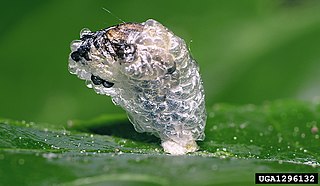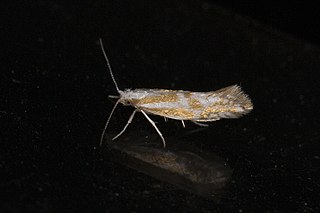Related Research Articles
Atralata is a genus of moths of the family Crambidae. It contains only one species, Atralata albofascialis, which is found in most of Europe, except Ireland, Great Britain, Norway, Finland, Lithuania and Greece.

Coleophora kuehnella is a moth of the family Coleophoridae. It was first described by Johann Goeze in 1783 and is found in Asia and Europe.
Caloptilia fidella is a moth of the family Gracillariidae. It is found from Germany to Italy and North Macedonia and from France to Russia and Ukraine.
Caryocolum proxima is a moth of the family Gelechiidae. It is found in most of Europe. It is also known from North America.
Coptotriche marginea is a moth of the family Tischeriidae. It is found in most of Europe.

Aproaerema anthyllidella is a moth of the family Gelechiidae. It is found in most of Europe, Kyrgyzstan, Iran and North America.

Adscita geryon, the cistus forester, is a moth of the family Zygaenidae. It is found in southern and central Europe, east to Turkey. It is also present in Great Britain.

Argyresthia abdominalis is a moth of the family Yponomeutidae. It is found in most of Europe, except Ireland, the Iberian Peninsula, Slovenia, Greece, Ukraine and Lithuania.

Argyresthia fundella is a moth of the family Yponomeutidae. It is found in most of Europe, except Ireland, Great Britain, the Iberian Peninsula, Finland, the Baltic region, Slovenia, Hungary and Greece.
Acrolepiopsis tauricella is a moth of the family Acrolepiidae. It is found Italy, Switzerland, Hungary and Ukraine.
Acrolepiopsis vesperella is a moth of the family Acrolepiidae. It is found in Germany, France, Spain, Portugal, Italy, Croatia, Serbia and Montenegro, Greece and on the Canary Islands.

Digitivalva arnicella is a moth of the family Acrolepiidae. It is found in Norway, Sweden, the Netherlands, Belgium, Denmark, Germany, France, Switzerland, Austria, Italy, Hungary, Slovakia, the Czech Republic, Romania, Poland and Lithuania.
Digitivalva perlepidella is a moth of the family Acrolepiidae. It is found in Great Britain, the Netherlands, France, Germany, Switzerland, Austria, Poland, the Czech Republic, Slovakia, Hungary, Croatia, Romania and Bulgaria.

Digitivalva reticulella is a moth of the family Acrolepiidae found in most of Europe, except Ireland, Great Britain, the Netherlands, France, Portugal, Slovenia, much of the Balkan Peninsula, and Lithuania.

Digitivalva pulicariae is a moth of the family Acrolepiidae. It is found in most of Europe, except Portugal, Fennoscandia, the Baltic region and Poland.
Euhyponomeutoides ribesiella is a moth of the family Yponomeutidae. It is found in Fennoscandia, Germany, Poland, Estonia, Ukraine, Slovakia, Austria, Belgium and France.

Aroga aristotelis is a moth of the family Gelechiidae. It is found in France, Spain, Italy, Ukraine, Romania, Bulgaria and Greece, as well as on Crete, Sicily and the Canary Islands. It has also been recorded from Turkey, Israel, the Ural Mountains, Iran and Turkmenistan.

Monochroa conspersella is a moth of the family Gelechiidae. In Europe, it is found from the Alps to the north. In the east, the range extends to the southern Ural and the Middle Volga, as well as Japan.

Exoteleia dodecella, the pine bud moth, is a moth of the family Gelechiidae. It is widely distributed from western Europe to Siberia. It is an introduced species in North America.
Bucculatrix argentisignella is a moth species in the family Bucculatricidae. It was first described by Gottlieb August Wilhelm Herrich-Schäffer in 1855 and is found in France and in disjunct populations in Central, Eastern and Northern Europe.
References
- ↑ Fauna Europaea
- ↑ lepiforum.de
- ↑ "bladmineerders.nl". Archived from the original on 2016-03-04. Retrieved 2012-07-04.